Mount Goode
July, 1974
In the Summer of 1974 I was in the process of relocating from Colorado
State University to the
University of Waterloo
so I returned to the Seattle area to reside with my mother,
do some research at the University of Washington and do some climbing.
I contacted Denny,
a former student who had been on the
Ptarmigan Traverse.
He agreed to accompany me on a climb of Mount Goode if I would accompany
him rafting down the Rogue River.
He had a climbing partner already,
so I needed to locate one.
Bill Sumner,
my instructor for the Intermediate Climbing Course,
ran a hole in the wall climbing shop frequented by many good climbers.
I posted a note on the bulletin board hanging in his shop and let him
know I was looking for a partner.
I was soon contacted by Eric Schwan,
who was on a climbing vacation from the east coast.
It turns out that Eric had done the
Index Traverse
and recalled my name from the
(still)
sparsely populated register.

The climb began with an early morning boat ride on the
Lady of the Lake
50 miles up
Lake Chelan
to the primitive settlement of
Stehekin.
At Stehekin,
one boards an old school bus that makes its way up and down a primitive
road,
dropping off and picking up climbers and hikers on the way.
Tourists also take this bus up and down as a day trip to see the sights.
This was after the
North Cascades Highway
was open,
but we did not consider using that access.
Even so,
the mountain is still relatively remote by the contiguous 48 states standards.

We got off the bus after about 14 miles to begin our hike up the Park
Creek valley.
The trail was not well maintained and had suffered a lot of damage from
avalanches in the Spring,
so the miles of scenic walking were interrupted by long sections of
broken trees we had to climb over with our heavy packs.
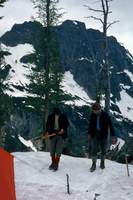
In spite of the boat ride,
bus ride,
4 miles of hiking and 5,000 feet of elevation gain,
we made good time and arrived at about 7,000 feet to prepare flat places in
the snow to set up our tents.
Mount Buckner is in the background.
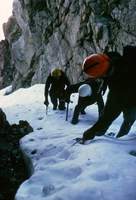
We got an early start the next morning to climb the northwest ridge of
Mount Goode.
This was a classic Cascades alpine climb involving both snow and rock.
We had our ice axes to help us ascend the steep gully leading to the
ridge,
and it was clear that rock helmets were advised.
Crampons would have sped our ascent,
but our packs were already heavy with other gear so we left them at
home.
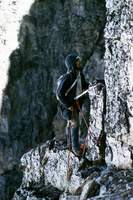
On the ridge the rock was very solid and made for good climbing.
Being the most experienced climber,
I tried to lead the crux,
still carrying my rucksack and wearing bulky mountaineering boots.
I discovered that climbing at a high standard
(especially with encumbrances)
is not like riding a bicycle:
unless you stay in practice you lose your edge.
I gave up and belayed Eric.
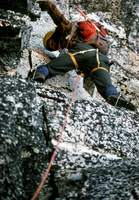
Eric's attempt got no further than mine.
Climbing this difficult rock section was complicated by the fact that we
were wearing heavy,
stiff mountaineering boots best used for tramping on trails and glaciers.
The specialized rock climbing shoes were another luxury we left behind to
make our packs lighter.
Finally,
Denny made an attempt without a rucksack and was able to get past the
difficult section.
We hauled our rucksacks up that pitch and continued on up the ridge.
Further along,
Eric lead a relatively easy section around a corner.
Eventually,
there was little rope left and I yelled a warning to him.
Apparently he could not hear me,
as the rope went tight;
I waited,
but no slack was forthcoming,
neither of us could hear the other and rope tugs were not answered.
Finally,
I got out of the belay and started climbing,
figuring that the rope was snaked through enough turns in the rock that
friction alone would make a belay unnecessary.
I climbed out onto the very exposed
northeast face;
at this point,
we were climbing through and up from the notch at the right of
this photo.
Eric was pulling the rope fast and I tried to keep up.
As I climbed over a large
(many tons)
boulder,
it came loose and started rolling down the face.
The rope came tight,
helping me scramble over the tumbling boulder.
I continued on to find Eric on a large level area,
standing and coiling the rope.
I told him what had happened and he said all he felt was a slight tug on
the rope.
He was not happy about the incident.
I was not sympathetic:
he was the one who had climbed beyond the limits of communication and
had continued to coil the rope when it should have been clear I was
climbing up to him.
Our slow progress left us short of the summit as sunset approached.
As we continued to climb,
Eric and I whispered between ourselves and agreed that a
bivouac
would be necessary;
Denny and his friend appeared to be unaware of our situation and we did not
see any reason to alarm them yet.
Upon reaching a suitable bivouac site,
Eric and I broached the subject and Denny objected strongly.
He insisted on an immediate descent as we pointed out that the sun would
set in much less than an hour,
giving us too little time to return to camp and precious little time to
prepare a bivouac.
He finally realized we were right and preparations began.
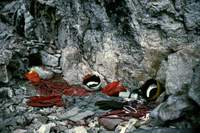
I partnered with Eric and Denny partnered with his friend to prepare two
sites since there was no place suitable for all four of us.
We had very little additional clothing,
no sleeping bags,
very little food and no stove.
We put on what clothing we had and spread our rucksacks, ropes and slings
to provide some insulation from the rock platform.
I had a
space blanket
in my emergency kit;
Eric and I huddled together under it.
Denny and his friend did the same with their emergency blanket.
The night before the temperature at camp was 26°F;
we were concerned that it would be colder at this elevation
(over 8,500 feet).
However,
we were now above the snow that created cold down-drafts at camp.
The low temperature was 40°F.
We shivered through the night and got very little sleep.
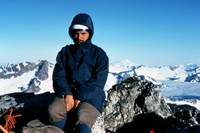
The morning sun was very welcome.
We got up and found a sunny spot to warm ourselves.
We had come too far and endured too much to miss this summit–
now only a few easy leads above us.
We quickly reached the summit.
I posed for a picture with Mount Baker and Mount Shuksan off my left
shoulder
(to the right in the picture)
and Mount Buckner just off my right
(left in picture).
The lack of sleep and food shows in my demeanor.
On the way to the summit,
some rocks dislodged and fell on my rope.
No-one was hurt,
but the rope was damaged and no longer reliable for holding a leader
fall.
After some testing we decided it would at least hold our weight during
rappels.
A couple of rappels put us onto the easy route and we made good time
getting back to camp.
After cooking and devouring yesterday's dinner and the morning's
breakfast we took a short rest.
Then we packed up and headed down the valley and up to Park Creek Pass.
Getting to the Park Creek Pass camp involved descending 3,000 feet to
the valley and climbing back up 2,000 feet to the pass.
This was about 4 miles of hiking with our heavy packs.
Here,
we again set up our tents on the snow and prepared for the next day's
climb of Mount Buckner.
The next morning I was beat and decided not to climb Buckner.
I showed the others how three could climb almost as fast as two and they
set off.
I spent the day relaxing,
reading and taking a short hike to get a view of Mount Logan.
As the sun got low,
I began to wonder about the others.
Checking their packs,
I determined that none had taken their headlamps so I took the headlamps
into the tent as darkness fell.
I pointed a headlamp up to illuminate the tent so it created a glowing
landmark.
After several hours of darkness I heard yelling in the distance and
turned on all the headlamps to give the returning climbers a target.
When they walked into camp they thanked me for giving them a beacon,
saying they would have been lost without it.
I offered to fix dinner for them,
but all were too tired to eat and immediately went to bed.
The next day we packed up and headed back down the valley to catch the
bus.
We managed to lose the trail several times in the avalanche debris.
The others were very tired from their ordeal,
so I would scout around to find the trail while they rested.
We had to hurry because if we missed the bus we would have to wait an entire
day for the next one.
We arrived back at the trailhead shortly before the bus.
The tourists on the bus were quite impressed by a bunch of smelly,
ragged looking guys carrying all sorts of strange equipment and insisted
that we tell them of our exploits as the bus rumbled back to Stehekin.







